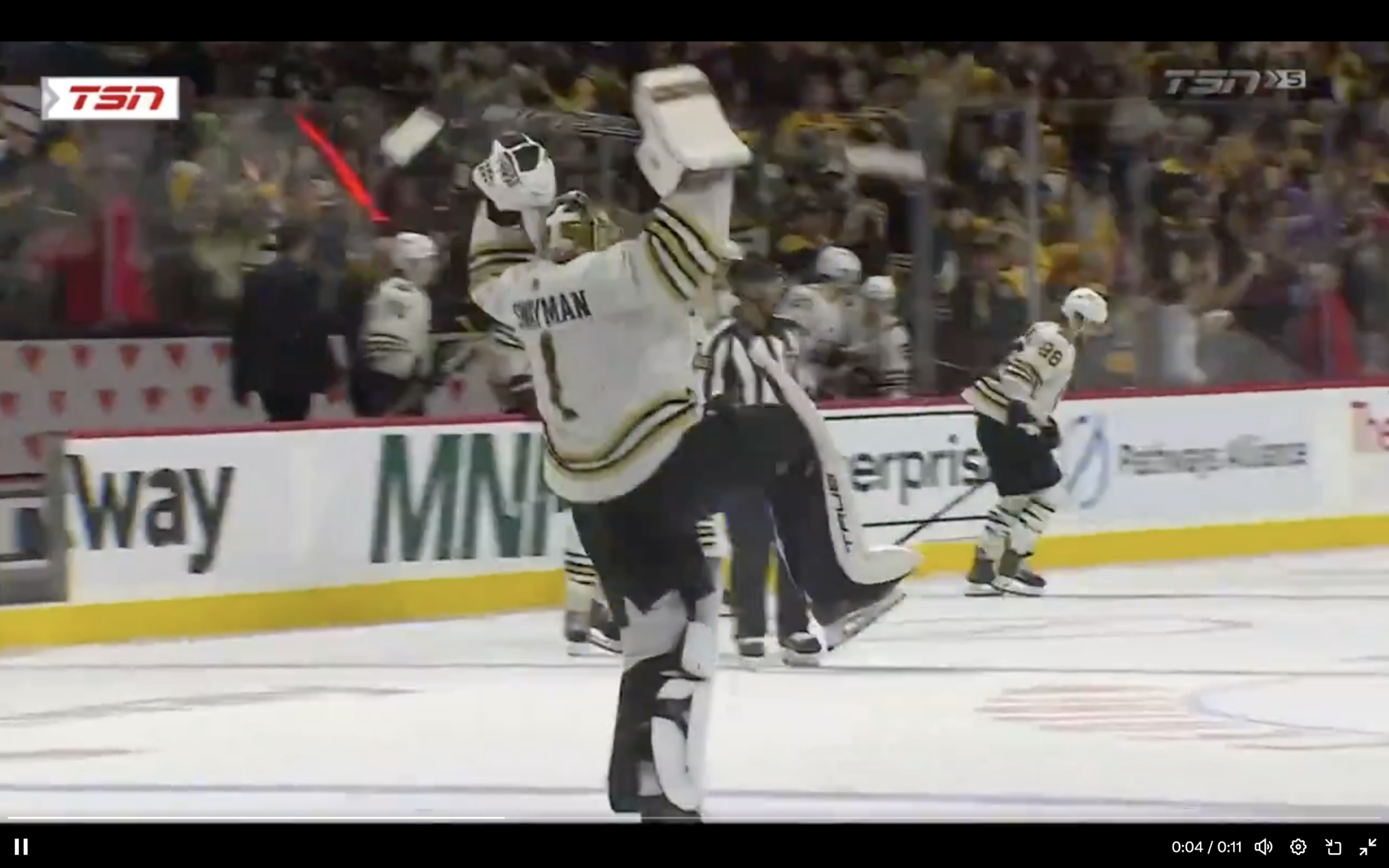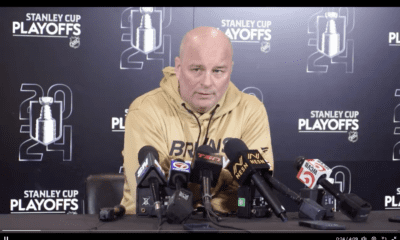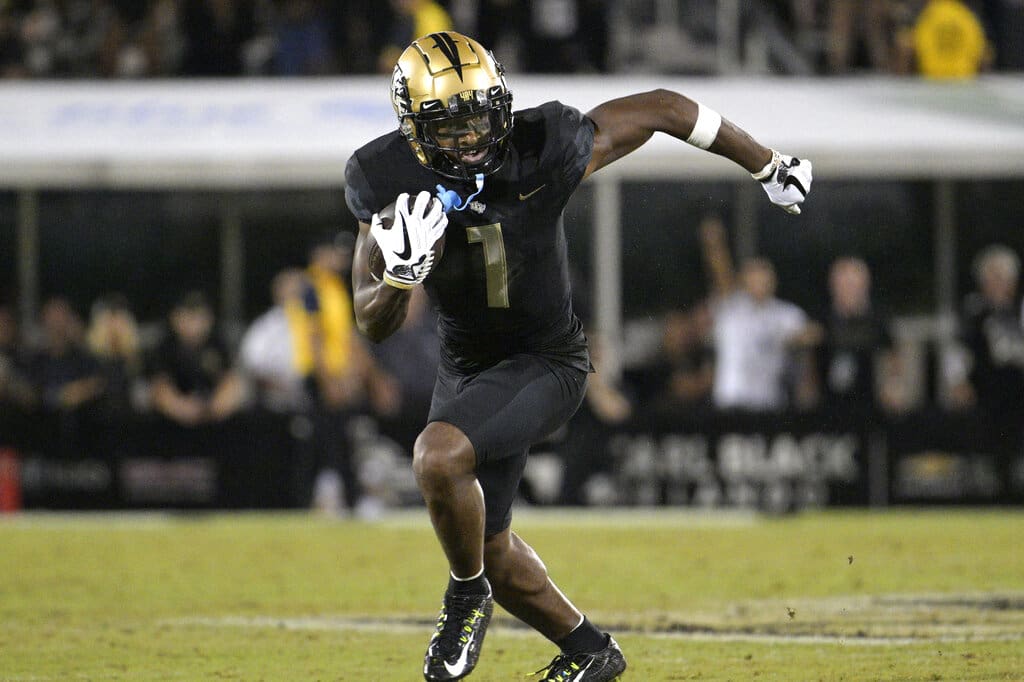Boston Bruins
Colageo: Boston Bruins Bring Back That Not-So-Loving Feeling

On August 6, 2023, I remember feeling quite unready for the bulletin that 1970s Boston Bruins great Gilles Gilbert had lost his battle with cancer. So Monday’s news that Blaine Lacher died unexpectedly in Medicine Hat, Alberta, at age 53 feels – way – too soon.
As the last starter of the old-Garden era, Lacher’s short career may be trivial to modern Boston Bruins history, but he was pivotal in another dimension.
Goaltending as an art was giving way in the 1990s to goaltending as a science. More-protective, lightweight gear combined with a more-detailed approach to team defense, leveraging a revolution in technique, even philosophy.
Whereas a face-molded, fiberglass mask of the ’70s would spare a goalie a facial fracture, the jolt most certainly would stop a game and the goalie might escape concussion. The merging of the cage with the best that goalie-mask gurus like Ernie Higgins had to offer brought this piece of equipment to a level that prevented not only serious injury but the trauma that accompanied a puck to the face at high speed.
At the same time, bulkier chest and arm protection allowed goalies to abandon archaic, puck-stopping strategies meant to avoid injury. Cutting down angles and giving shooters less space has always been core to the goaler’s gameplan, but how they did that was as unique and quirky as the arenas in which they played.
While goaltending was simplified by better equipment, the ever-increasing speed of the game shifted focus from what is happening in the moment to what is likely to happen next. Anticipation, long considered a nuance, became fundamental, and saves outside of live situations were rehearsed.
Style points between goaltenders are harder to detect in today’s game.
The stand-up technique so prevalent in the 20th century was rendered obsolete by the emergence of a playing style that was ironically considered quirky when Glenn Hall and Tony Esposito were its torch bearers in the 1960s and ’70s. Now the dragging of goalie pads is universally foundational to the position.
It’s in this case that Lacher becomes more than a footnote in that he was the Boston Bruins’ first, true, butterfly-style goalie.
I’ll forever remember a unique encounter with the then-rookie in the Bruins’ dressing room in the final season of the old Boston Garden. All 48 games of the lockout-shortened schedule were played in 1995, and the former Lake Superior State starter finished his first NHL season 19-11-2 with a 2.41 goals-against average and a .902 save pct.
I was eager to ask Lacher about the playing style that was taking over pro hockey at the time.
His pads hung behind him on the wall, but Lacher jumped up from his locker bench, dropped to his knees and launched into a show-and-tell of how the butterfly works. With ease, he moved his lower legs while his knees were locked together.
Lacher played his second NHL season only 9 inches away in what we now know as TD Garden, but his game was miles away from where it had been in college and as a rookie pro. It wasn’t long before Lacher was out of the NHL and then out of pro hockey altogether.
As much as the mid ’90s are a relatively forgettable chapter of Boston Bruins hockey, Lacher’s brief spell in the their net remains significant. As an aside, after the great Bill Ranford briefly returned to Boston in 1996, I asked him about the butterfly. The 1990 Conn Smythe winner as playoff MVP (at Boston’s expense) said, “my body won’t do it.”
Speaking of bodies that won’t do it, Thatcher Demko’s brushoff at Jeremy Swayman’s offer of a goalie hug at All-Star Weekend accomplished one thing: With that single gesture, Demko has endeared himself to the Roberto Luongo generation of Vancouver fans still aching to exact revenge upon the Boston Bruins.
With Rick Tocchet behind the bench, their young nucleus (and everyone’s favorite journeyman J.T. Miller) keying their emergence as a legitimate Stanley Cup contender, the Elias Lindholm acquisition is a statement that the Canucks are on a mission.
Now should the less-is-more Boston Bruins make an improbable playoff run this year, especially with Brad Marchand wearing the “C,” imagine the collision course between these teams. Everyone else who played in the 2011 Cup final has retired except defenseman Chris Tanev, who still skates 20 minutes a night for Calgary but was ironically not sent back to Vancouver in the Lindholm deal. A pending UFA, Tanev has a 10-team, no-trade list. I wonder who’s not on it.
Perennially picking near the bottom of the first round of the NHL Entry Draft, the Boston Bruins have emptied their cupboard bolstering recent playoff rosters. Maybe with Charlie Coyle elevating his game, the Bruins would still have let Lindholm go to Vancouver and Sean Monahan from Montreal to Winnipeg.
The Boston Bruins can make an impact acquisition, but it would require parting with a goalie and/or another roster player. Without draft capital to offer, GM Don Sweeney must decide if what is available is worth moving on from players who likely won’t be Boston Bruins next season anyway.
Unlike 2023, Sweeney’s 2024 wish list will not include rentals. Technically, Jake DeBrusk and Matt Grzelcyk are his rentals. Anyone coming to Boston at the trade deadline in exchange for the aforementioned or Linus Ullmark will have term remaining on his contract.
I don’t know what I enjoyed more in Friday night’s Skills Competition, David Pastrnak missing that open net – good thing that wasn’t a Bruins-Leafs playoff game – or The Nikita Kucherov Comedy Hour. Both were obviously better in Saturday’s All-Star Game.
Thanks to full-out, All-Star attendance, the heightened challenges in the Skills Competition and the aforementioned pratfalls, this was easily the NHL’s most compelling All-Star Weekend since Kendall Coyne Schofield wowed the elites with her explosive crossovers during the 2019 fastest-skater competition. Coyne Schofield clocked a 14.326-second lap and awakened many to the athleticism in women’s hockey.
As for Pasta, you knew he’d do something memorable, but that miss, especially coming at the tail end of a brilliant puck-handling exhibition, was pure gold. Glad it didn’t matter.
But back to Kucherov, the supremely talented winger who competed on Friday like he had driven solo from Tampa and just made it to Toronto in time to pull on his skates.
It seemed for several years that landing an All-Star Game was tantamount to the NHL quietly telling a city it would never host an outdoor game, much less the Winter Classic. Some consolation prize, a game veteran All-Stars preferred to miss, enjoy a vacation, and pay a fine.
But this All-Star Weekend seemed different, like Montreal in 2009 when the Canadiens were celebrating their franchise centennial.
All the stars came out, even the injured ones. Those who could compete gave it their all, except for Kucherov, whom the Lightning should have put on LTIR (for old times’ sake) with the upper-body injury that resulted from the arm-twisting it took to get him to Toronto.
I’m not so sure about that big IIHF tournament reportedly coming to Boston and Montreal. The NHL never announced exactly which cities will be named hosts.
Anytime an international event and Boston are mentioned in the same sentence, I think of the winter of 1995-96 when TD Garden opened as the FleetCenter and the Boston Bruins were in line for their first NHL All-Star Game since 1971.
That winter the IIHF also brought the World Junior Championships amidst a blizzard and a flu bug that ran through the Sergei Samsonov Russian squad.
There were too many empty seats at those games.
On the other hand, Causeway, over the last five years, has developed into a hopping scene for commuters, concert goers, business travelers, area residents, and is now a game-day destination for Bruins and Celtics fans even when they don’t have tickets.
If the NHL chooses Boston this time, North Station won’t disappoint.


















